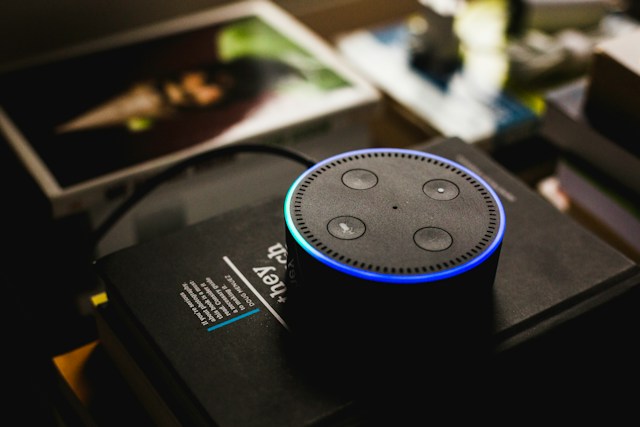Voice recognition tech has gained serious popularity over the last few years, and, based on its success, a lot of people clearly find it useful. But, without certain authorizations, it’s largely glorified calendars, search engines, and music players.
So, what happens when we enable interactive voice response (IVR) to make purchases on our behalf? Today, we look at the impact of voice payment technology and whether we’re really ready for these changes.
What is Voice Payment Technology?
Voice payment technology is a system that can process financial transactions based on verbal input. This concept isn’t new—we’ve seen mobile service carriers and other businesses use automated voice payments for years.
But this tech has kept pace with the times. Now, it’s commonly used alongside cloud telephony services, and a major selling point for virtual assistants like Alexa is how they can quickly and easily order items at your request.
How do Voice Payments Work?
Voice payment technology is an application of IVR tech. Voice recognition is the most complicated part. Aside from that, it’s like any other payment service. It uses a virtual wallet along with debit or credit card info provided by the user. Once this is set up, they no longer have to input any more non-verbal information.
Voice payment systems are a prominent example of software as a service (SaaS). Some IVR companies promote their products via a domain to symbolize the input/output nature of the tech.
AI’s Role in IVR
The renewed focus on voice payment technology is due, in part, to the recent AI boom. Artificial intelligence (AI) plays a key role in modern IVR systems, as demonstrated by tools like Alexa and Google Voice.
AI-driven voice recognition is the next step up from those old, pre-recorded phone tree prompts of years past. These algorithms can interpret wording and tone to deliver a bespoke response.
Of course, one of the main benefits of AI is its capacity for self-improvement. With traditional software, developers would have to implement and test improvements bit by bit. However, machine learning can develop its own understanding and analytical capabilities independently. This is really important for things like accent comprehension.
That said, we’re now seeing governments worldwide begin trying to legislate for artificial intelligence (like the EU’s AI Act). Such legislation may end up being pivotal to future business regulations, so it’s important to be aware of it—especially if you’re running an international company.
The Potential Impact of Voice Payments
Today, we live in a world where technology is constantly reshaping how we live and work. Things we’re used to now would have seemed like science fiction even ten years ago. AI is just one example; another is how remote screen sharing has transformed collaboration.
So, the question remains: how will the proliferation of voice payment technology impact us?
Restructuring Organizations
Voice payment technology could affect how we structure businesses in all sorts of ways. For one thing, it may be another nail in the coffin of cash-based companies (similar to the impact of online retailers with smaller upkeep costs than brick-and-mortar stores).
The improvement of voice payment systems is also likely to be one of the more significant call center technology trends, especially when it comes to machine learning-driven IVR.
AI that can handle customer transactions and queries stand to streamline call centers in a big way. As a result, we could see a reduction in the number of “standard” call center jobs versus an increase in the number of system management roles.
Integrated payments are becoming increasingly relevant, with businesses exploring ways to incorporate voice payment technology into their operations, potentially enhancing transaction processing and customer interactions.
This includes the possibility of utilizing voice commands for various tasks, such as generating invoices using a pre-designed invoice template.

If you do much tech-based reading online, you’ve probably heard the term “Internet of Things.” That’s because IoT technology is all around us.
The “Internet of Things” refers to the ever-growing network of online-connected devices that interact with us and each other (from our computers and phones to smartwatches, personal assistants, and even WiFi-connected refrigerators).
The IoT is the framework by which modern omnichannel marketing achieves a seamless customer experience. Voice payment technology is simply the next link in that chain. As it develops, people will have more avenues through which to make purchases. Pretty soon, you might be able to shop for groceries just by talking to your fridge.
Future Trust and Security Concerns
Along with all the ways voice payments might revolutionize our lives, people also have their share of worries.
In some ways, it’s an issue of consumer trust. Giving personal information to a voice they can’t see makes people feel more vulnerable than simply filling out an online form. On the one hand, it’s a matter of how alien the process feels, but there are also people who are put off by the idea of technology becoming too personalized.
There are also very real, tangible security issues to consider. When technological complexity increases, it becomes more likely that someone will find a workaround in the system. And, since virtual assistants have to retain banking information for voice payments to work, there’s a risk of financial info being stolen.
Not needing to remember passwords or PINs is great—after all, it means you can access funds and make purchases more easily—but that also applies to prospective cybercriminals.
Even voice recognition-based security may not be enough, as we’ve already seen how AI can effectively replicate a person’s voice given enough sample audio. However, there are some options for safeguarding voice payment data.
Take 8×8’s cloud communications, for example. Cloud-based communications benefit from a greater range of security options, plus more flexibility and the capacity for updates. So, this may be a safer option than relying on a third-party infrastructure.
Other security options include encryption from beginning to end (E2EE), not to mention address verification services (AVS). E2EE uses cryptographic keys to encode and decrypt information at each end, and AVS compares user-supplied address details with those kept by banking service providers. This helps ensure legitimacy and prevent crime.
Voice Payment Technology is the New Normal
No matter how you feel about voice payment technology, it looks like it’s here to stay. More and more businesses seem to be lining up to create seamless omnichannel purchasing systems. But, as widespread as voice payments already are, we’ve yet to see them peak.
So, if you’re hoping that voice payments will go the way of 3D glasses and shoes with toes, don’t hold your breath. They’re an enticing prospect for both consumers and businesses.
For consumers, it’s simply a matter of convenience, but for businesses, IVR tech represents limitless opportunities for customer engagement and conversion. That’s a huge incentive for them to make voice payment technology our new normal.
